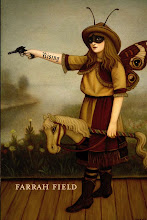Salter's Faulknerian, Hemingwayishness of story-telling combines a sort of lush spareness with decisive imagery. Or maybe it's not even imagery. I don't really care what these characters look like or what the room looks like, but they all seem to be in a place that I know, in time that I can feel passing. I'm trying to say Salter's prose has movement, Alice Munro movement. "They have turned off the light. In the room there is a huge armoire, a wicker basket, chairs. A metal tree on which garments can be hung. The ceiling is very high. In its center--one's eyes must be accustomed to the dark--a grotesque fixture. The hours pass. She is pinioned on the bed, her arms trapped beneath her, her legs forced wide. Her eyes are closed. The radio is playing Sucu Sucu. The world has stopped. Oceans still as photographs. Galaxies floating down. Her cunt tastes sweet as fruit" (64). Who doesn't want to read more? It jumps and pivots and sometimes just kind of floats. I usually throw up on airplanes, but I made myself finish this book on my journey home. I just couldn't go through another day with it unread.
There's so much to say, but I'm kind of tired from my flight. Change is something I think about often, what really changes someone, if anyone changes. I used to think that place changed a person, that you could be anything if you were in the right place. After reading A Sport and a Pastime, I wonder if it isn't physical love, not even love really, but someone else's flesh that makes you feel alive or scared a bit, definitely more yourself. Change through physical discovery--that's what I scribbled on the top of page 123 anyway.








